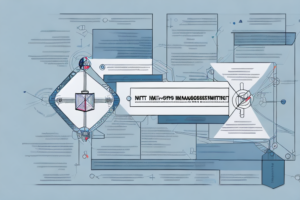What is Step 4 of RMF process?
8 min read
A four-step process
The Risk Management Framework (RMF) process is a structured approach used to manage risks associated with information systems. It covers the full lifecycle of these systems, from design to operation and is an essential component of ensuring the security of sensitive information. Step 4 of the RMF process is a crucial stage, focusing on the assessment of security controls that have been implemented to protect the information system.
Understanding the Risk Management Framework (RMF) Process
The RMF process is a NIST recommended guideline that provides organizations with a disciplined and structured approach to managing information security risks. It is used by federal agencies and their contractors to manage organizational risk to the confidentiality, integrity, and availability of information and information systems. The RMF process consists of six steps:
- Categorization
- Selection of Security Controls
- Implementation of Security Controls
- Assessment of Security Controls
- Authorization to Operate
- Continuous Monitoring
The RMF process is not a one-time event, but rather a continuous cycle of assessing and managing risks. It is important for organizations to regularly review and update their security controls to ensure they are effective in mitigating risks. Additionally, the RMF process emphasizes the importance of communication and collaboration between different stakeholders, including system owners, security personnel, and senior management, to ensure a comprehensive and effective risk management strategy.
Overview of the 6 Steps of the RMF Process
The first step in the RMF process is categorization, in which the system is classified based on its impact level and risk tolerance. The second step is the selection of security controls, where controls are chosen to mitigate the identified risks. In the third step, the selected security controls are implemented and tested to ensure their effectiveness. The fourth step is the assessment of security controls, which involves the evaluation of implemented controls to determine their effectiveness. Authorization to operate, the fifth step, involves the decision of whether the system can proceed to production, based on the assessment results. Finally, in the continuous monitoring phase, the system is monitored to ensure that it operates within the expected parameters and continued compliance with the required security controls.
It is important to note that the RMF process is not a one-time event, but rather a continuous cycle. After the system has been authorized to operate, it is important to continue monitoring and assessing the security controls to ensure that they remain effective and up-to-date. This includes regular vulnerability scans, penetration testing, and security assessments. Any changes to the system or its environment should also be evaluated to determine if they impact the security posture of the system. By continuously monitoring and assessing the system, organizations can ensure that their systems remain secure and compliant with the required security controls.
The Importance of Step 4 in the RMF Process
Step 4, the security control assessment, is essential to ensure adequate security controls have been implemented and functioning correctly. The testing conducted in this step enables the identification and closure of any security vulnerabilities or weaknesses in the system. It proves to management and other stakeholders that the security controls are operating as expected and providing the necessary protection for the system. Therefore, it helps to minimize the risk of potential security breaches and the impacts on the confidentiality, integrity, and availability of the system.
Additionally, Step 4 provides valuable feedback to the system owners and operators on the effectiveness of their security controls. This feedback can be used to improve the security posture of the system and to make informed decisions on future security investments. Furthermore, the security control assessment is a requirement for compliance with various regulations and standards, such as FISMA and NIST SP 800-53. Therefore, completing Step 4 is not only important for the security of the system but also for meeting regulatory requirements.
What are the Objectives of Step 4 in RMF?
The primary objective of Step 4 is to evaluate the implemented security controls and determine their effectiveness in mitigating the associated system risks. This step also ensures compliance with relevant security policies and procedures and validates the accuracy of security documentation. The security control assessment process in step four also helps to identify the residual risk level, which is the risk level after the implementation of security controls.
Additionally, Step 4 involves conducting a penetration testing or vulnerability assessment to identify any weaknesses or vulnerabilities in the system. This testing helps to ensure that the security controls are functioning as intended and that there are no gaps in the system’s security posture. The results of the testing are used to make any necessary adjustments to the security controls and to further reduce the system’s risk level.
Common Challenges Faced During Step 4 of RMF
One of the significant challenges faced during the security control assessment phase is insufficient documentation. Without adequate documentation, it is challenging to identify the implemented security controls in the system and assess their effectiveness. Another challenge could be the lack of clarity in assessing the security controls’ results, which could lead to incorrect conclusions and decisions. Resource constraints, such as limited personnel or expertise, could also pose challenges during the security control assessment phase.
Another challenge that organizations may face during the security control assessment phase is the lack of proper communication between different teams involved in the process. This can lead to misunderstandings and delays in the assessment process, which can ultimately affect the overall security posture of the system. It is essential to establish clear communication channels and ensure that all teams involved in the assessment process are on the same page.
Additionally, the complexity of the system being assessed can also pose a challenge during the security control assessment phase. The more complex the system, the more difficult it is to identify and assess all the security controls effectively. It is crucial to have a thorough understanding of the system’s architecture and design to ensure that all security controls are appropriately assessed and implemented.
Best Practices for Implementing Step 4 of RMF
The following are some best practices for implementing Step 4 of RMF:
- Ensure adequate documentation on the implemented security controls is available.
- Establish clear criteria and guidelines for security control assessment.
- Conduct security control assessment in an objective and unbiased manner.
- Ensure that the test environment simulates the production environment accurately.
- Test the security controls effectively to identify any vulnerabilities.
- Report all findings to the authorizing official before making any decisions.
It is important to note that Step 4 of RMF involves continuous monitoring and ongoing assessment of security controls. This means that organizations should regularly review and update their security controls to ensure they remain effective against evolving threats. Additionally, organizations should consider implementing automated tools and processes to streamline the monitoring and assessment process, and to quickly identify and respond to any security incidents.
How to Conduct a Successful Security Control Assessment in Step 4 of RMF
The following are the typical steps for conducting a successful security control assessment in Step 4 of RMF:
- Begin by reviewing system documentation thoroughly.
- Determine the security control testing methods, tools, and techniques to be used.
- Next, identify the personnel who will be involved in the security control assessment.
- Conduct the security control assessment, record your findings, and ensure compliance with applicable regulatory documents.
- Document any issues discovered during the security control assessment phase and recommend corrective action plans.
- When corrective action has been completed, conduct a follow-up assessment to ensure compliance.
It is important to note that during the security control assessment phase, it is crucial to maintain open communication with all stakeholders involved in the process. This includes system owners, security personnel, and any other relevant parties. By keeping everyone informed and involved, potential issues can be identified and addressed in a timely manner, ultimately leading to a more successful security control assessment.
Key Players Involved in Step 4 of the RMF Process
The critical players involved in Step 4 of the RMF process include the authorizing official, the security control assessor, the IT security team, and the system owner.
The authorizing official is responsible for making the final decision on whether or not to authorize the system to operate. They review the security assessment report and make sure that all risks have been identified and addressed before granting authorization.
The security control assessor is responsible for conducting the security assessment of the system. They evaluate the effectiveness of the security controls in place and identify any vulnerabilities or weaknesses that need to be addressed.
What Happens After Completing Step 4 of RMF?
After the completion of Step 4, the security control assessment report is delivered to the authorizing official for review and decision-making. The authorizing official considers all the findings and artifacts generated in Step 4 to determine the residual risk level and decide whether or not to authorize the system for operation.
If the authorizing official decides to authorize the system for operation, the system can move on to Step 5, which involves continuous monitoring and ongoing assessment of the system’s security controls. However, if the residual risk level is deemed too high, the authorizing official may require additional security controls to be implemented or may choose to not authorize the system for operation. In this case, the system will need to undergo further assessment and remediation before it can proceed to Step 5.
How to Ensure Compliance with NIST Guidelines During Step 4 of RMF
To ensure compliance with NIST guidelines during Step 4 of RMF, the following should be considered:
- Use NIST-recommended security controls and guidelines to identify and evaluate controls in the system.
- Ensure that the security control assessment process follows NIST guidelines and has been implemented appropriately.
- Ensure that all artifacts required for compliance with NIST guidelines are present.
- Conduct due diligence in providing evidence of compliance with NIST guidelines.
It is important to note that compliance with NIST guidelines is an ongoing process and not a one-time event. Regular monitoring and updating of security controls and procedures are necessary to maintain compliance. Additionally, it is recommended to stay up-to-date with any changes or updates to NIST guidelines and adjust security measures accordingly.
Case Studies: Examples of Successful Implementation of Step 4 in RMF
There are numerous successful case studies of step 4 implementation of RMF. In one example, a government agency completed RMF step 4 by conducting security control assessment to identify the vulnerabilities in the information system. The security control assessment revealed security vulnerabilities that could lead to potential cyberattacks, therefore this allowed personnel to implement controls to mitigate those risks.
Another success story comes from a federal healthcare company implementing RMF. They used step 4 to complete a security control assessment and identified vulnerabilities that required action. The security team then implemented controls that helped mitigate risks and consequently enabled the system to receive authorization for operation.
Conclusion
Step 4 of the RMF process is an essential component of ensuring information system security. It assesses the implemented security controls’ effectiveness and helps identify vulnerabilities in the system. To conduct a successful security control assessment, adequate documentation, clear guidelines, and an objective and unbiased approach should be applied. Compliance with NIST guidelines should also be a consideration. Successful implementation of this step is a crucial element in determining an information system’s risk posture and ensuring its security.



